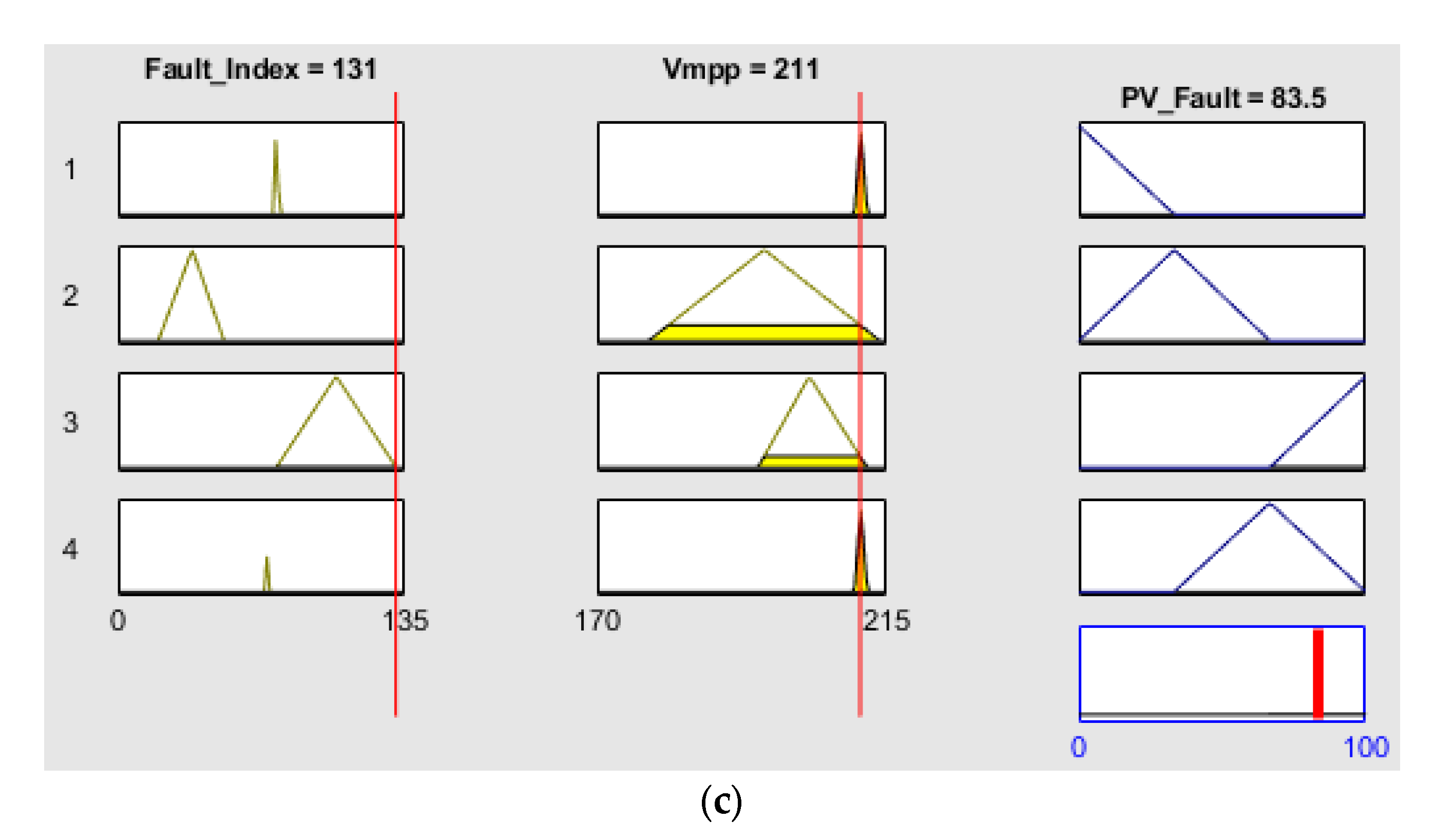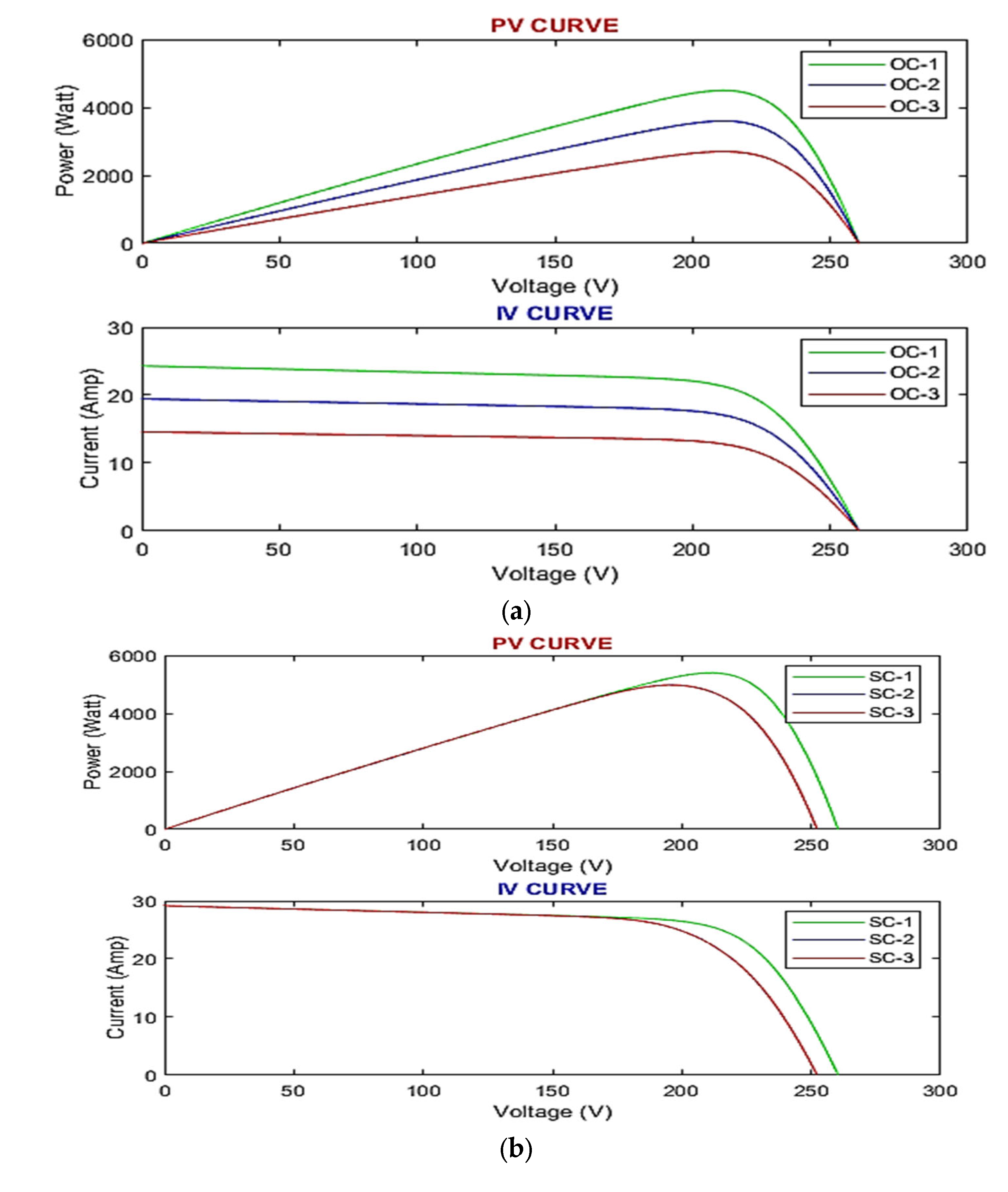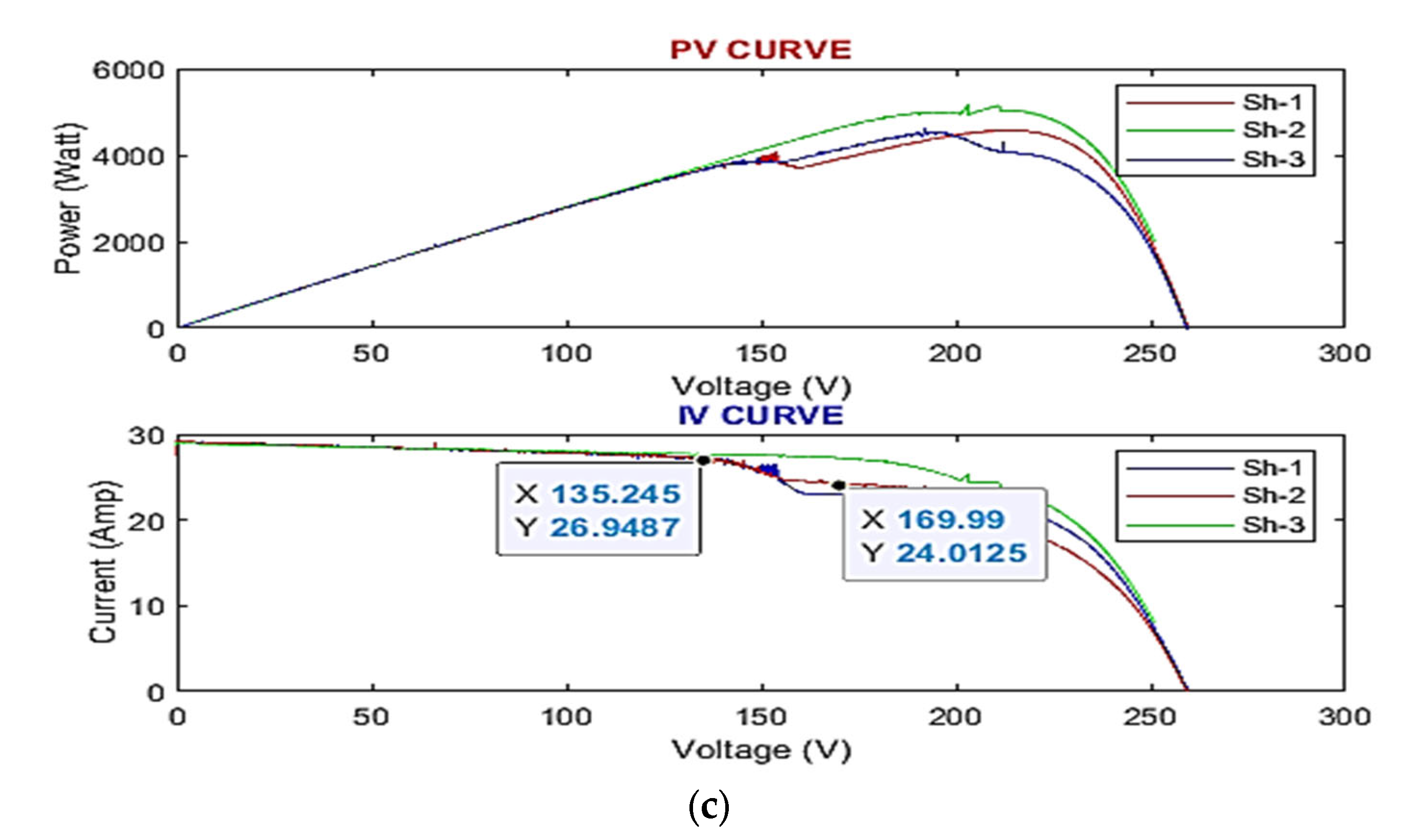Over the past two decades, remarkable growth in the photovoltaic (PV) market has been seen due to relatively increased efficiency and reduced cost of PV modules. Significant power generation, around 115 GW, was recorded in 2019 [
1]. With the increasing trend and reliance on photovoltaic systems, fault detection and diagnosis techniques have been becoming more critical for a safe and reliable operation of PV plants. Faults, such as crack, short-circuit, and open-circuit faults, cause undesirable impacts on solar PV systems including reduced efficiency and damage to PV facilities [
2]. Short-circuit current and open-circuit voltage are affected due to shading, open and short-circuit faults. In addition to that, the open-circuit voltage can also be lower due to the effect of temperature. Additionally, the low short-circuit current may occur due to less irradiance, encapsulant damage, reduction in light trapping, and/or it may occur due to cracks. However, in this research work, reduction in light trapping and encapsulant damage are not considered because both are manufacturing and accidental mechanical defects and require a lot of external sensors. Several fault detection techniques have been proposed in the literature including a model-based approach, real-time difference method, output signal analysis, and machine-learning-based techniques such as deep-learning-based methods [
3]. Among the listed methods, this paper focuses on machine and deep-learning-based techniques which are considered faster with greater accuracy reaching 91% [
4]. The following reviews the literature of machine- and deep-learning-based fault detection techniques and classification at both module and array levels.
1.1. Machine-Learning-Based Fault Detection
An ANN algorithm was proposed for shadowing fault detection and demonstrated through a 3.15 kW PV system. A major limitation of the technique is its complexity and inability to be utilized for other types of faults [
5]. ANN requires a large data set based on variations in input. In the case of open-circuit (OC) and short-circuit (SC) faults, the input conditions for the ANN become closer to binary, i.e., “fault is present or is not present”. In open circuit faults the current becomes zero while in short-circuit faults the voltage becomes zero. ANN has a multi-layer operational procedure. The greater the input, the higher the accuracy will be. Therefore, it is obvious that the ANN will be computationally underloaded for detection of OC and SC faults because a lot of computational power and resources might be wasted. A Bayesian belief network was also used to detect various faults in grid tied PV installations in [
6]. A fuzzy logic (FL)-based algorithm in [
7] was presented for several abnormalities such as shading, water infiltration, and damaged diodes in addition to open-circuit, and line-to-line faults. The approach was evaluated and classified by the application of decision trees (DT) achieving an accuracy of 98.9% [
8]. An artificial neural network (ANN) was also utilized based on three key parameters temperature, current, and voltage at the maximum power in [
9] to detect shading, degradation, and short-circuit faults of a PV installation. An improved fuzzy logic approach was also proposed in [
10] relying on measured increases in series resistance (R
s) providing binary results (yes/no).
A method for detecting arc faults was also presented in [
11] relying on peak detection, frequency analysis, and observation of the operating point. In [
12], module level temporal faults are identified by using a new introduced technique based on ANNFL with over 86% accuracy. However, line-to-line, line-to-ground, and short-circuit faults remain difficult to detect under low solar irradiance. In [
13], shading, short circuits, and aging of PV installation are classified by the application of radial basis function–extreme learning machine (RBF-ELM) with an accuracy of 93.55%.
Short circuits and shading faults in PV installation are classified by using a fuzzy classifier based on theoretical parameters extracted from I-V curves in [
14], with a classification accuracy of 95.3%. Abnormal aging, open-circuit and short-circuit faults are classified by using a LSSVM scheme in a Bayesian model and verified experimentally with an accuracy of 97.5% in [
15]. In [
16], the authors proposed a KELM procedure for identification and classification of partial shading, open circuit, short-circuit, and degradation faults of PV systems.
In [
17], the authors proposed a multiclass SVM for identification and classification of abnormal degradation and line-to-line faults occurred at module level by using two different factors: fill factor (FF) and Kalman filter (KF). In [
18], a PV system of 9.54 kW is subjected to two different probabilistic NN classifiers trained on a dataset of 11,840 readings, for detection of a disconnected and short-circuited panel through a reverse metering system. In [
19], the authors implemented a C4.5 DT procedure, a kind of supervised learning, for detection and classification of short, circuited modules. In [
20], a genetic algorithm is employed for identification and localization of open-circuit and short-circuit faults; however, its accuracy diminishes under different shading patterns. All the reviewed techniques above are limited by the size of arrays.
In [
21], the authors employed a RFEL practice for detection and diagnosis of degradation, line–line, open-circuit, and partial shading faults. However, the proposed technique is not able to localize faults. In [
22], the authors discussed the application of the KNN algorithm for detection and classification of partial shading, short-circuit, open-circuit, and line-to-line faults for a PV system of size 3 × 3. A comparative analysis of ANN and FL implemented on a 1.1 kW PV installation was presented in [
23]. It has been concluded that the detection accuracy of ANN is better than FL, which is approximately 92.1%.
In [
24], a fuzzy-logic-based offline technique is proposed to automate classification process of progressive faults such as delamination through thermal imaging techniques and ethylene-vinyl acetate (EVA) discoloring which is a challenging task due to the camera signal noise and atmospheric temperature variations. In [
25], the authors proposed a graphical exponentially weighted moving average (EWMA) technique based on Shewhart and k-NN algorithms for detection of short-circuit, open-circuit, and temporary shading faults based on various parameters such as the current, voltage and power at the maximum power in addition to the irradiance and temperature. Short impacts of shading, open/short circuits, and snow covering on a PV installation have been investigated and faults are classified accordingly in [
26], based on different parameters extracted from 720 I-V curves, which is a very complex process. In [
27], three different classes of cracks for PV modules are detected and differentiated by using RF classifiers based on 735 electroluminescence images. A summary of the ML based techniques for PV fault detection including key contribution literature gaps is presented in
Table 1.
1.2. Deep Learning Techniques
DL procedures are employed to resolve various problems of detection and diagnosis of faults, such as manual features extraction, single hidden layer, overfitting problems, low performance, and shallow ANNs. Conventional deep learning techniques particularly require large data sets of thermal or electroluminescence images [
28,
29,
30,
31,
32,
33,
34].
Various DL algorithms have been found more effective in pattern recognition of fault images and their classification accordingly. In [
35], faults such as snail trails, yellowing, delamination, gridline corrosion, and dust-shading are detected, classified, and localized by the application of DCNN and SVM on 7560 PV images obtained through unmanned aerial vehicles.
Line–line and open circuits of PV installation are identified on the basis of a dataset obtained through 2D representation of PV voltage and current and achieved high accuracy in [
36]. In [
37], partial shading, open-circuit, short-circuit, and degradation faults are detected and diagnosed by using a CNN with 2D ResNet, but a large data set is required for detection.
Table 2 presents a brief overview of different deep leaning algorithms for fault detection.
The major contribution of this research work is as follows:
Faults are detected and classified in both series parallel and total cross tied configuration.
Existing fuzzy logic techniques are employed for detection of a single fault at a time. Our proposed approach addresses the issue by detecting multiple faults at a time.
The proposed approach is applicable for large systems.
This research work proposes, for the first time, a fault index based on a linear trend line-based approach which makes detection accurate and simple.
This research work establishes a data set of a PV system of different faults with different severity levels.
This technique classifies faults based on severity levels, so that the relevant protection scheme can be adopted accordingly.

















